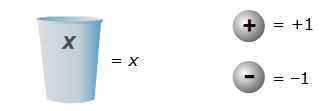
In the last section, you used algebra tiles to set up and solve one-step equations involving addition and subtraction. In this section, you will use a different model composed of cups and counters to set up and solve one-step equations involving multiplication and division.
For the cups and counters model, a cup represents the variable, usually x, and counters are used to represent numbers.

Consider the equation 3x = 15. This equation can be modeled with cups and counters with 3 cups on the left side of an equal sign and 15 positive counters on the right side of an equal sign.

![]() Click through the interactive below to see how Sandy used cups and counters to solve this equation. Click the Next arrow to step through how Sandy did it.
Click through the interactive below to see how Sandy used cups and counters to solve this equation. Click the Next arrow to step through how Sandy did it.
![]() Use the cups and counters model below to set up and solve each of the equations shown.
Use the cups and counters model below to set up and solve each of the equations shown.
Now, consider the equation x over 4 x 4 = 5. This equation uses the operation of division.
![]() Click through the interactive below to see how Sandy used cups and counters to solve this equation. Click the Next arrow to step through how Sandy did it.
Click through the interactive below to see how Sandy used cups and counters to solve this equation. Click the Next arrow to step through how Sandy did it.
When you are dividing counters evenly among the cups, what do you do if there is a counter left over?

If you were solving the equation, x over 7 x 7 = 2, into how many pieces would you need to divide the picture of the cup in order to solve the equation?

How are the operations of multiplication and division related?
How does this relationship help you to solve equations?
For Questions 1 – 3, use the cups and counters model to determine the value of x.